Deep-Learning-Based Stress-Ratio Prediction Model Using Virtual Reality with Electroencephalography Data
Abstract
1. Introduction
1.1. Research Background and Purpose
1.2. Research Scope and Method
2. Theoretical Considerations
2.1. Electroencephalogram
2.2. Virtual Reality
2.3. Features of Hitler’s Chancellery
2.4. Research Contributions
3. Experimental Outline and Equipment
3.1. Outline
3.2. Experimental Equipment
3.2.1. Virtual Reality Instruments
3.2.2. EEG Measurement Tool
3.3. Experimental Measurement and Methods
3.3.1. Experimental Measurement
3.3.2. EEG Experimental Method
4. Experimental Results and Analysis
4.1. First Analysis (Beta Waves Only)
4.2. Secondary Analysis (Alpha, Beta, Theta, Gamma and Delta Waves)
5. Conclusions
- The results of similar data demonstrated that the building was indeed designed to induce feelings of grandiosity and trepidation and that the feelings experienced by the president of Czechoslovakia, who had a heart attack in the residence, were obtained.
- The results of the stress index analysis based on the EEG data revealed that when the subject sensed changes in pressure in the high floor space as he moved from a higher floor to a lower floor, he experienced changes in space, which were reflected by an increase in the stress index, indicating that the subject was in a psychologically tense state.
- Comparing EEG data from the subject moving from the Court of Honor with a 25 m tall floor to the Führerbunker with a 3 m tall floor, the total intensity of the beta wave, which is related to stress, was found to be relatively large when the spaces changed. The graph of the experimental results showed that the most significant change in stress was observed when the subject entered the Führerbunker, with a 3 m high floor, from the Mosaic Hall, with a 15 m high floor, owing to these spaces having the largest floor difference.
- Two methods were used to analyze the emotions that the user felt in the VR space based on the EEG signals: a method of expressing unpleasant regions according to time information based on the beta wave that represented stress among the EEG signals and a method of operating deep learning to predict the stress ratio through a correlation analysis of all EEG signals by ranking the regions according to the level of stress. A comparison of the results of the two analysis methods revealed different results from each datum. The first analysis showed that the amount of changes in the beta wave index were high during spatial transitions. In the second analysis (stress ratio analysis), the index was found to be high in the spatial transition at the entrance to and inside the Mosaic Hall. Particularly notably, the corresponding index was high in the space where the subject entered a 15 m high floor through a narrow entrance. Both results were meaningful for analyzing an architectural space. However, in the VR space, we found it necessary to analyze the positive indices through the linking process of the EEG signals or the stagnation of pupils on certain architectural design elements. Therefore, in future research, a VR experiment of a building space must be performed by fusing eye-tracking equipment with VR and EEG equipment. Accordingly, the effective pattern must be calculated by integrating the process for data collection by the sensors of each piece of equipment through integration with deep learning.
Author Contributions
Funding
Conflicts of Interest
References
- Kim, Y.; Jun, M. A Study on characteristics of monumental expressions in the contemporary architecture. J. Arch. Inst. Korea Plan. Des. 1999, 19, 499–504. [Google Scholar]
- NDR. Umtriebig und Umstritten: Architekt Cäsar Pinnau. Abgerufen am 9. 2020. Available online: https://www.ndr.de/geschichte/Caesar-Pinnau-ein-umstrittener-Architekt,pinnau104.html (accessed on 5 April 2020).
- Florian Müller-Klug: Hitlers Büros in Berlin—Teil 1: Die Reichskanzlei und die Neue Reichskanzlei. In: Clio Berlin Blog, 14. 2014. Available online: https://clioberlin.de/blog-architektur/70-hitlers-bueros-in-berlin-teil-1-reichskanzlei-und-neue-reichskanzlei.html (accessed on 20 April 2020).
- Dobesberger, J.; Walser, G.; Unterberger, I.; Embacher, N.; Luef, G.; Bauer, G.; Benke, T.; Bartha, L.; Ulmer, H.; Ortler, M.; et al. Genital automatisms: A video-EEG study in patients with medically refractory seizures. Epilepsia 2004, 45, 777–780. [Google Scholar] [CrossRef] [PubMed]
- Sudjic, D. The Edifice Complex: The Architecture of Power; Penguin; Jakkajungsin: Seoul, Korea, 2011. [Google Scholar]
- Hwang, Y.; Kim, S.; Kim, J. An analysis of youth EEG based on the emotional color scheme images by different space of community facilities. J. Korean Inst. Int. Des. 2013, 22, 171–178. [Google Scholar] [CrossRef]
- Song, M.; Yoon, S.; Kim, K. A Study on the impacts of the experiential factors of architectural media interaction on the selective attributes. J. Arch. Inst. Korea 2016, 36, 67–68. [Google Scholar]
- Strijkstra, A.M.; Beersma, D.G.; Drayer, B.; Halbesma, N.; Daan, S. Subjective sleepiness correlates negatively with global alpha (8–12 Hz) and positively with central frontal theta (4–8 Hz) frequencies in the human resting awake electroencephalogram. Neurosci. Lett. 2003, 340, 17–20. [Google Scholar] [CrossRef]
- Song, M.; Shin, H.; Baek, G.; Kim, H.; Kook, C. A basic study on the characteristics of the electroencephalogram corresponded with the evaluating words of sound scape sound source. KIEAE J. 2011, 11, 49–56. [Google Scholar]
- Basar, E.; Basar-Eroglu, C.; Karakas, S.; Schurmann, M. Are cognitive processes manifested in event-related gamma, alpha, theta and delta oscillations in the EEG? Neurosci. Lett. 1999, 259, 165–168. [Google Scholar] [CrossRef]
- Krigolson, E.; Williams, C.; Norton, A.; Hassall, D.; Colino, L. Choosing MUSE: Validation of a Low-Cost, Portable EEG System for ERP Research. Front. Neurosci. 2017, 11, 1–10. [Google Scholar] [CrossRef]
- Lee, G.; Kim, D.; Choi, C. Electroencephalogram; Korea Medical Book Publishing Company: Seoul, Korea, 2001; pp. 1–5. [Google Scholar]
- Al-Shargie, F.M.; Tong, B.T.; Nasreen, B.; Masashi, K. Mental stress quantification using EEG signals. In Proceedings of the International Conference for Innovation in Biomedical Engineering and Life Sciences, Putrajaya, Malaysia, 6–8 December 2015; Springer: Singapore, 2015; pp. 15–19. [Google Scholar]
- Al-Shargie, F.; Tong, B.T.; Nasreen, B.; Masashi, K. Towards multilevel mental stress assessment using SVM with ECOC: An EEG approach. Med. Biol. Eng. Comput. 2018, 56, 125–136. [Google Scholar] [CrossRef]
- Al-Shargie, F.; Tong, B.T.; Masashi, K. Assessment of mental stress effects on prefrontal cortical activities using canonical correlation analysis: An fNIRS-EEG study. Biomed. Opt. Express 2017, 8, 2583–2598. [Google Scholar] [CrossRef]
- Al-Shargie, F.; Masashi, K.; Nasreen, B.; Sarat, C.D.; Ahmad, F.M.H.; Tong, B.T. Mental stress assessment using simultaneous measurement of EEG and fNIRS. Biomed. Opt. Express 2016, 7, 3882–3898. [Google Scholar] [CrossRef]
- Kim, J.Y.; Lee, H.S. A Study on Interior Wall Color based on Measurement of Emotional Responses. Korean Soc. Emot. Sensib. 2009, 12, 205–214. [Google Scholar]
- Rhu, J.S.; Lee, J.S. Correlation Analysis of Emotional Adjectives and EEG to Apply Color to the Indoor Living Space. J. Korean Soc. Color Stud. 2015, 29, 25–35. [Google Scholar]
- Kim, H.S.; Lym, J.H.; Kim, H.T.; Kim, H.S.; Gwak, W.T.; Kim, J.H. Effect of Thermal Environment and Illuminance on the Occupants Works based on the Electroencephalogram and Electrocardiogram Analysis. Sci. Emot. Sensib. 2014, 17, 95–106. [Google Scholar] [CrossRef]
- Kim, Y.J.; Shin, D.J.; Kim, J.Y. A study on the characteristics on brain wave of indoor space lighting by EEG experiment. J. Korea Inst. Spat. Des. 2019, 14, 71–79. [Google Scholar]
- Maghelal, P.; Prathiba, N.; Jody, R.N.; Byoung-Suk, K. Investigating the Use of Virtual Reality for Pedestrian Environments. J. Arch. Plan. Res. 2011, 28, 104–117. [Google Scholar]
- Hollander, J.B.; Foster, V. Brain Responses to Architecture and Planning: A Neuro-Assessment of the Pedestrian Experience in Boston, Massachusetts. Arch. Sci. Rev. 2016, 59, 474–481. [Google Scholar] [CrossRef]
- McKinsey Global Institute. Big Data: The Next Frontier for Innovation, Competition and Productivity. Available online: https://bigdatawg.nist.gov/pdf/MGI_big_data_full_report.pdf (accessed on 5 April 2020).
- Shin, Y. A basic study for the sense of real improvement in virtual reality. J. Arch. Inst. Korea Plan. Des. Sect. 2005, 21, 11–18. [Google Scholar]
- Kim, J.; Chang, S.; Jun, H. Comparison of reality and virtual reality spatial electroencephalogram measurement data. J. Arch. Inst. Korea 2018, 38, 107–110. [Google Scholar] [CrossRef]
- Moon, J. The study on the applicability of virtual reality headset to space design field through focus group interviews. J. Integr. Des. Res. 2014, 13, 33–44. [Google Scholar] [CrossRef]
- Lin, C.H.; Hsu, P.H. Integrating procedural modelling process and immersive VR environment for architectural design education. MATEC Web Conf. 2017, 104. [Google Scholar] [CrossRef]
- Mccomas, J.; Pivik, J.; Laflamme, M. Children’s transfer of spatial learning from virtual reality to real environments. Cyberpsychol. Behav. 1998, 1, 115–122. [Google Scholar] [CrossRef]
- Ken, P.; Matthias, J.G.; Sarah, P.; Lukas, M.; Daniel, B.; Florian, A. Behavioural Biometrics in VR: Identifying People from Body Motion and Relations in Virtual Reality. In Proceedings of the 2019 ACM CHI Conference on Human Factors in Computing Systems (CHI’19), Glasgow, Scotland, UK, 4–9 May 2019; pp. 110:1–110:12. [Google Scholar] [CrossRef]
- Colin, E. Places of the Heart: The Psychogeography of Everyday Life; Bellevue Literary Press, NYU School of Medicine: New York, NY, USA, 2016. [Google Scholar]
- Freeman, D.; Reeve, S.; Robinson, A.; Ehlers, A.; Clark, D.; Spanlang, B.; Slater, M. Virtual reality in the assessment, understanding, and treatment of mental health disorders. Psychol. Med. 2017, 47, 2393–2400. [Google Scholar] [CrossRef] [PubMed]
- An, T.; Kim, M. Single person household and producing VR content Korean single person household and HMD. Korea Inst. Des. Res. Soc. 2016, 1, 21–28. [Google Scholar]
- Muse Headband. Available online: https://choosemuse.com (accessed on 2 February 2019).
- Balconi, M.; Crivelli, D. Handbook of Sport Neuroscience and Psychophysiology; Routledge: Abingdon-on-Thames, UK, 2019; pp. 40–69. [Google Scholar]
- Park, J.; Kang, S.; Lee, B.; Kang, U.; Lee, Y. Design of user concentration classification model by EEG analysis based on visual SCPT. J. Korea Soc. Comput. Inf. 2018, 23, 129–135. [Google Scholar]
- Denoising EEG Brainwaves with Machine Learning. Available online: https://blog.goodaudience.com/denoising-eeg-brainwaves-with-machine-learning-239598740f09 (accessed on 20 February 2020).
- Salazar, A.; Vergara, L.; Miralles, R. On including sequential dependence in ICA mixture models. Signal Process. 2010, 90, 2314–2318. [Google Scholar] [CrossRef]
- Safont, G.; Salazar, A.; Vergara, L.; Gómez, E.; Villanueva, V. Multichannel dynamic modeling of non-Gaussian mixtures. Pattern Recog. 2019, 93, 312–323. [Google Scholar] [CrossRef]
- Som, M.G.; Heo, G.; Choi, J.I. Development of Visualization and Statistical Analytics System for Electric Power using Tableau. Proc. Korean Inst. Inf. Sci. Eng. Conf. 2017, 3, 16–18. [Google Scholar]
- Tableau. Available online: www.Tableau.com (accessed on 4 February 2020).
- Zhao, H. Facebook HiPlot ‘Makes Understanding High Dimensional Data Easy’, SyncedReview. Available online: https://syncedreview.com/2020/02/03/facebook-hiplot-makes-understanding-high-dimensional-data-easy/ (accessed on 4 February 2020).
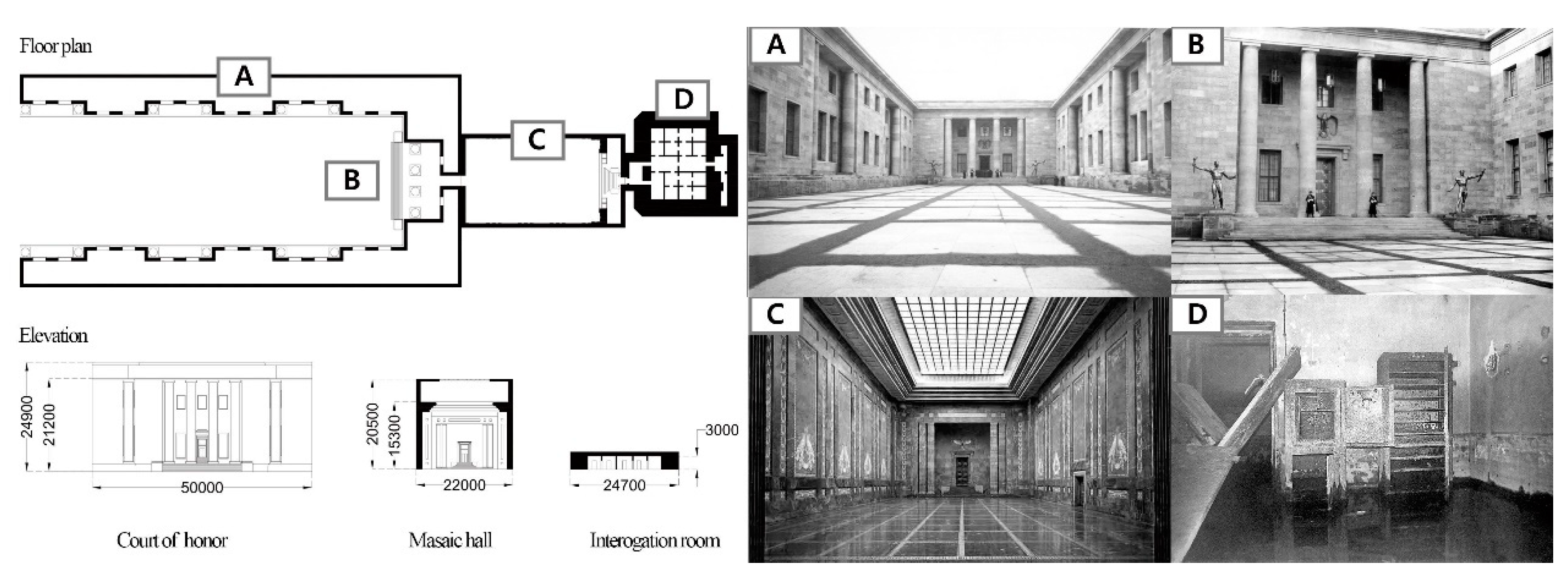


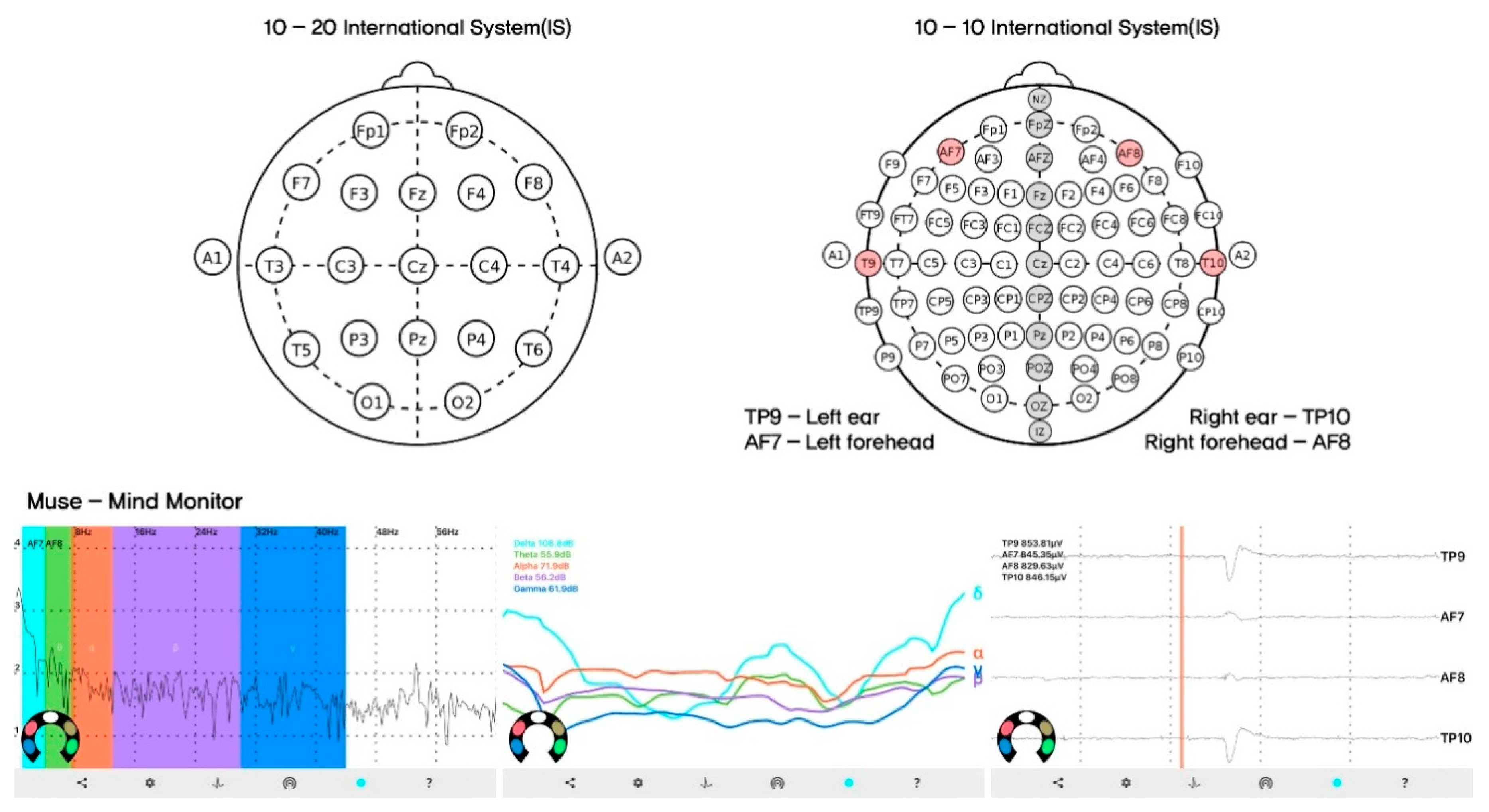
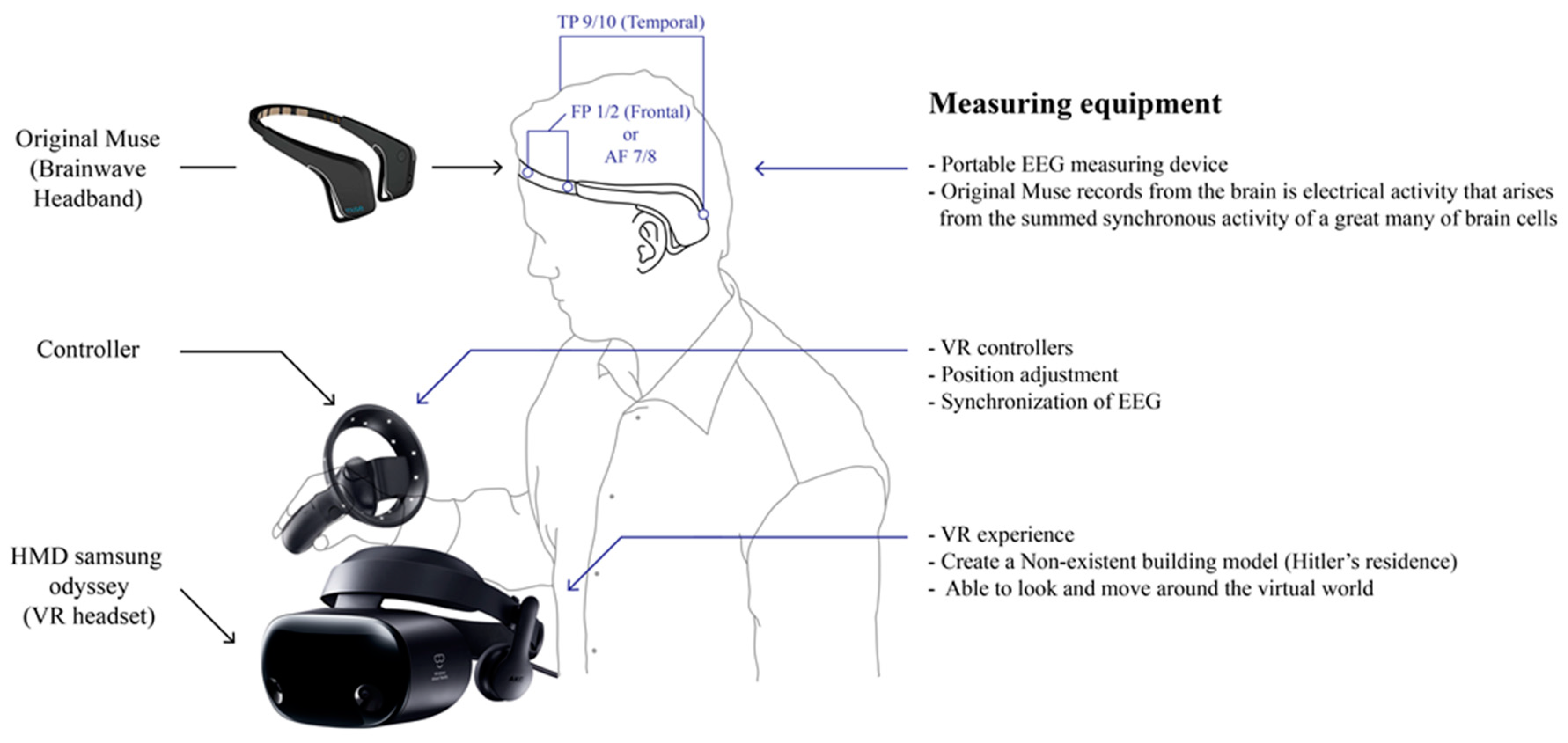
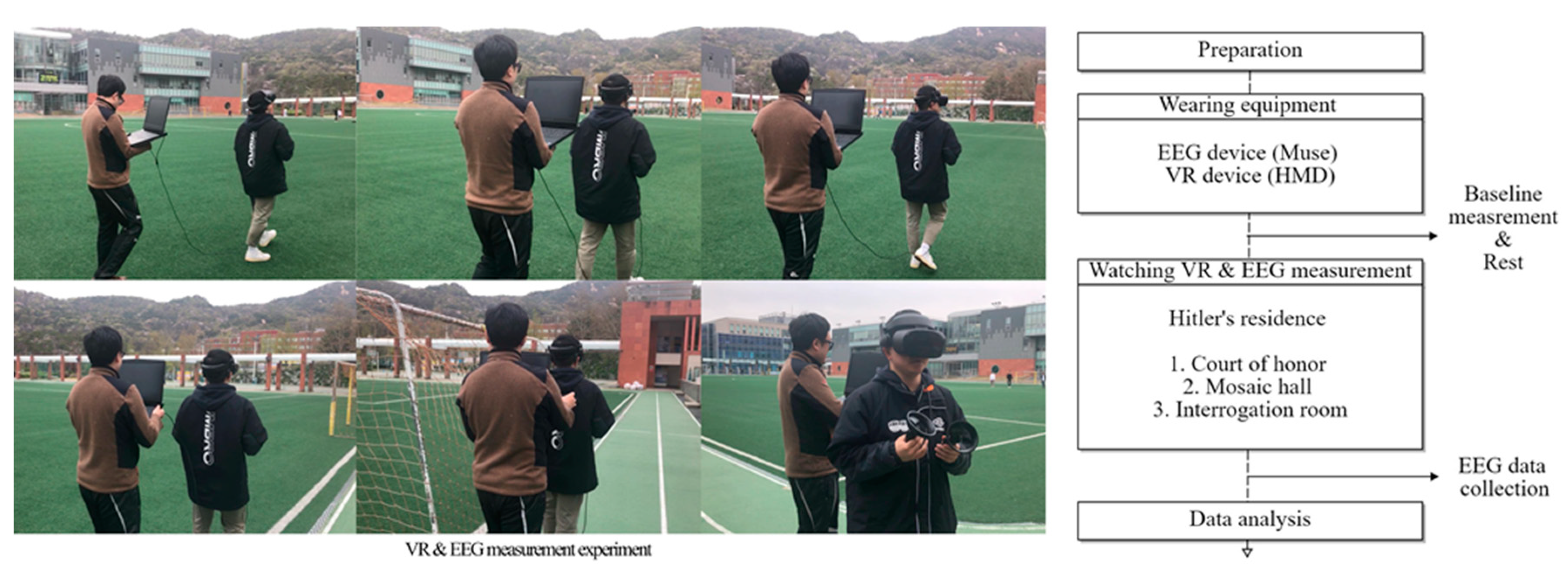
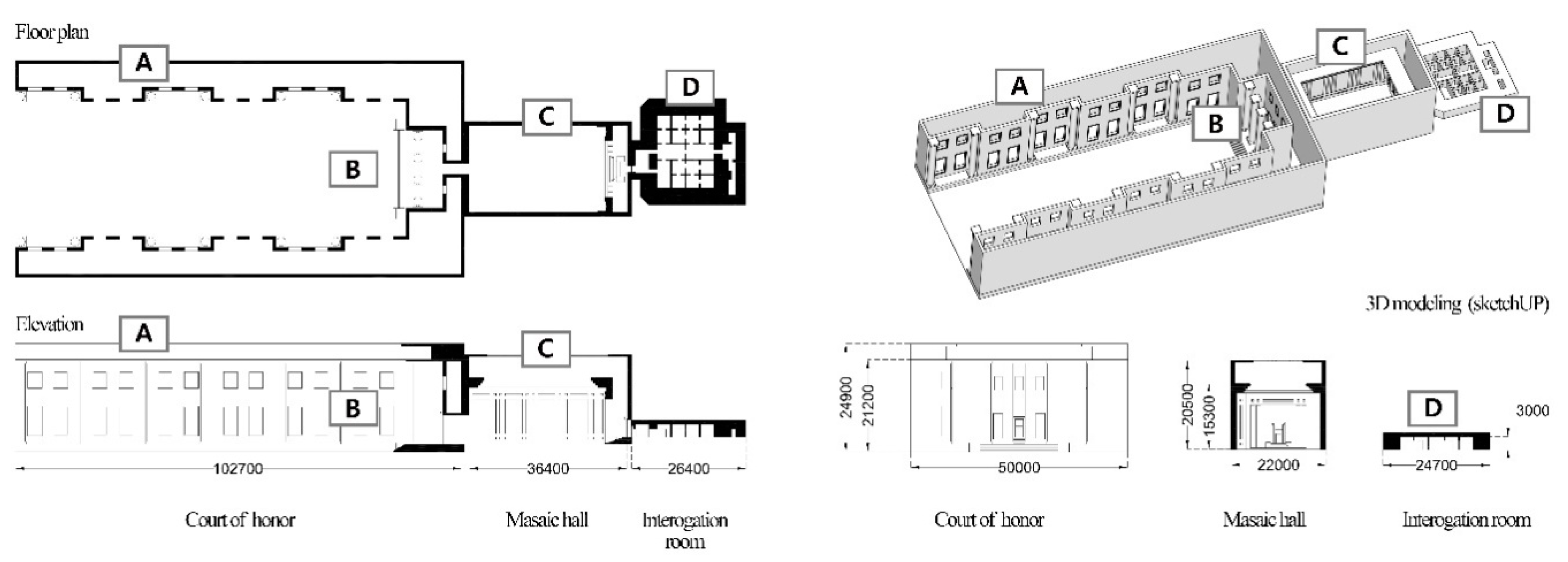

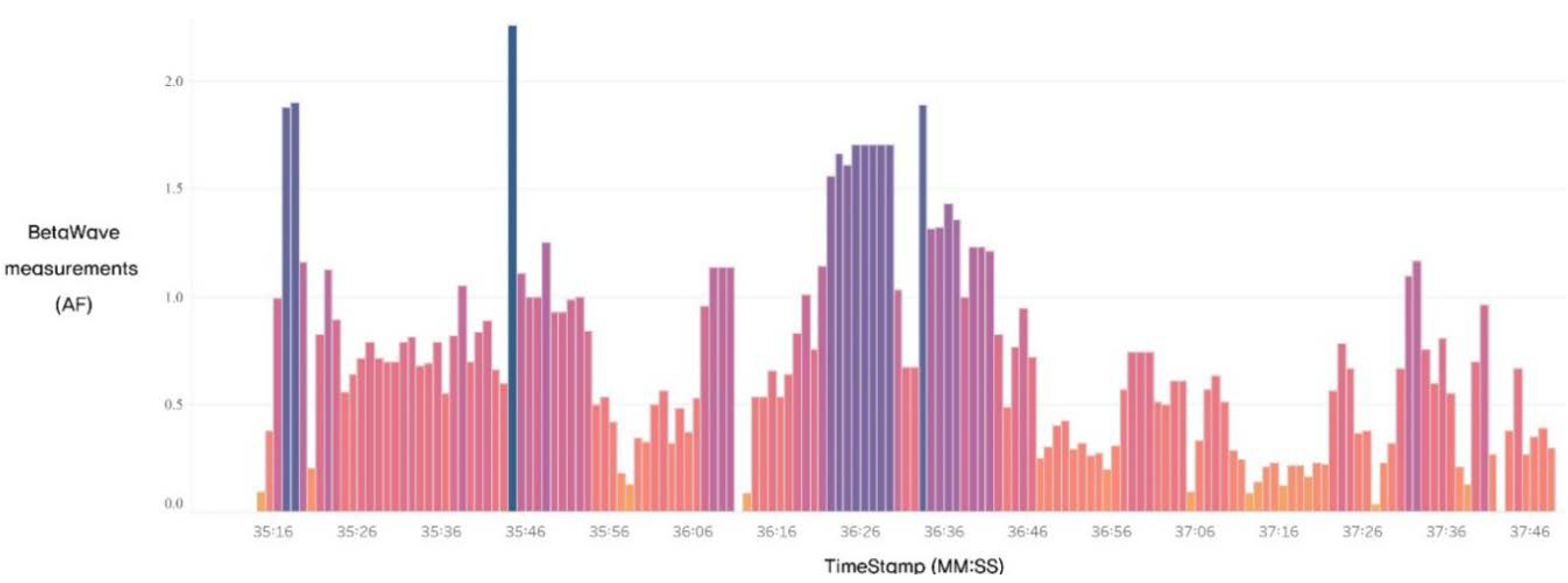
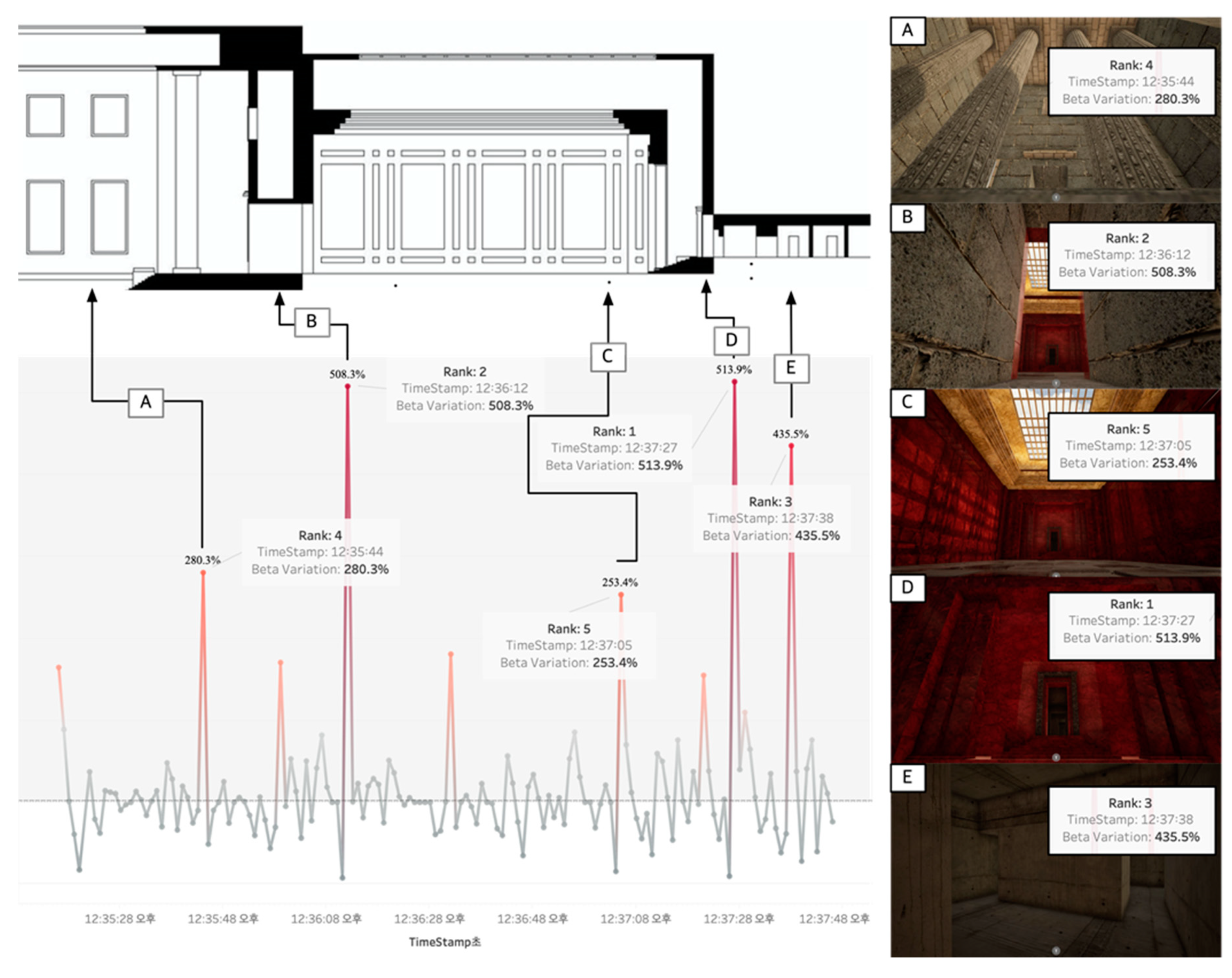
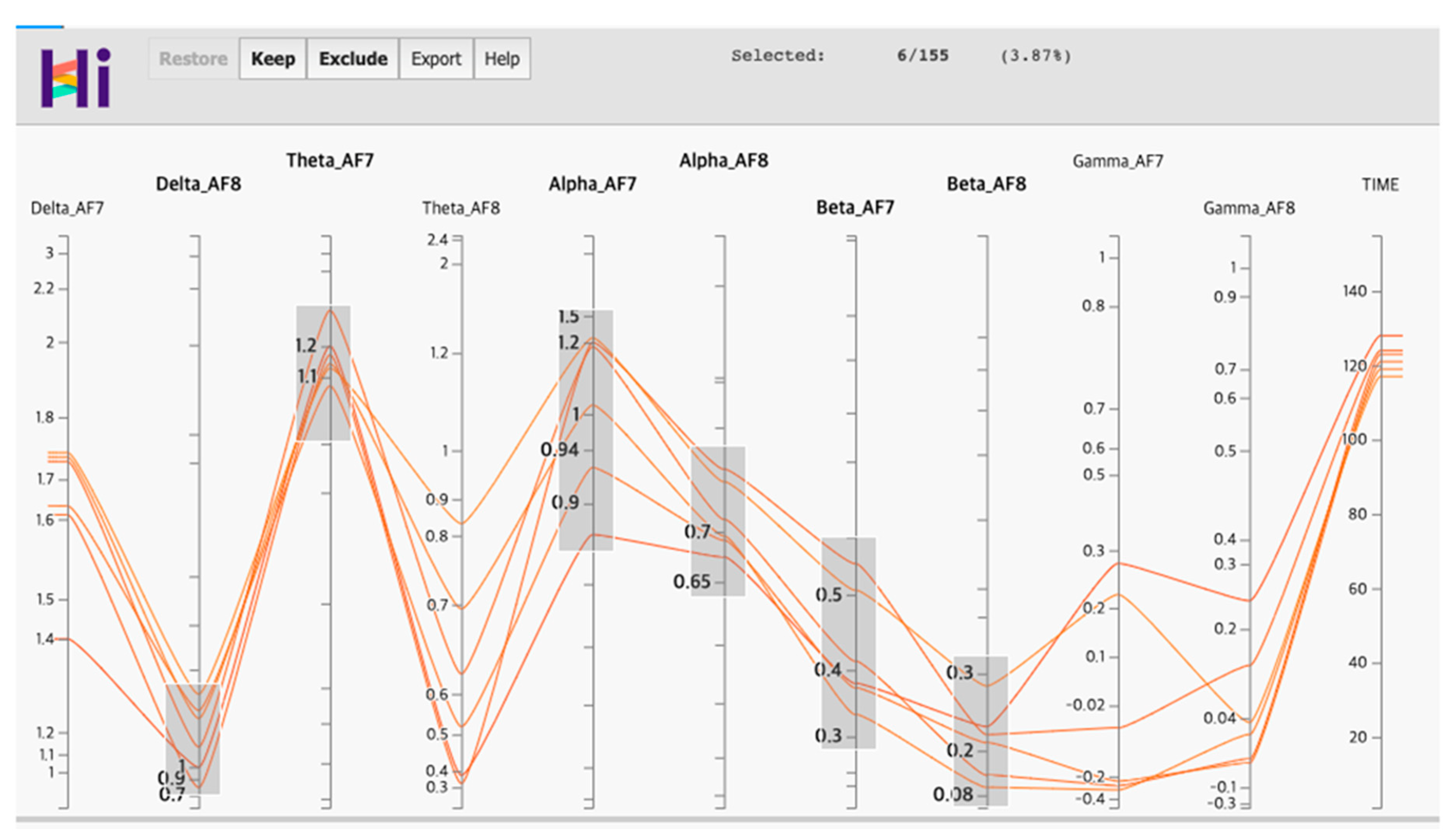
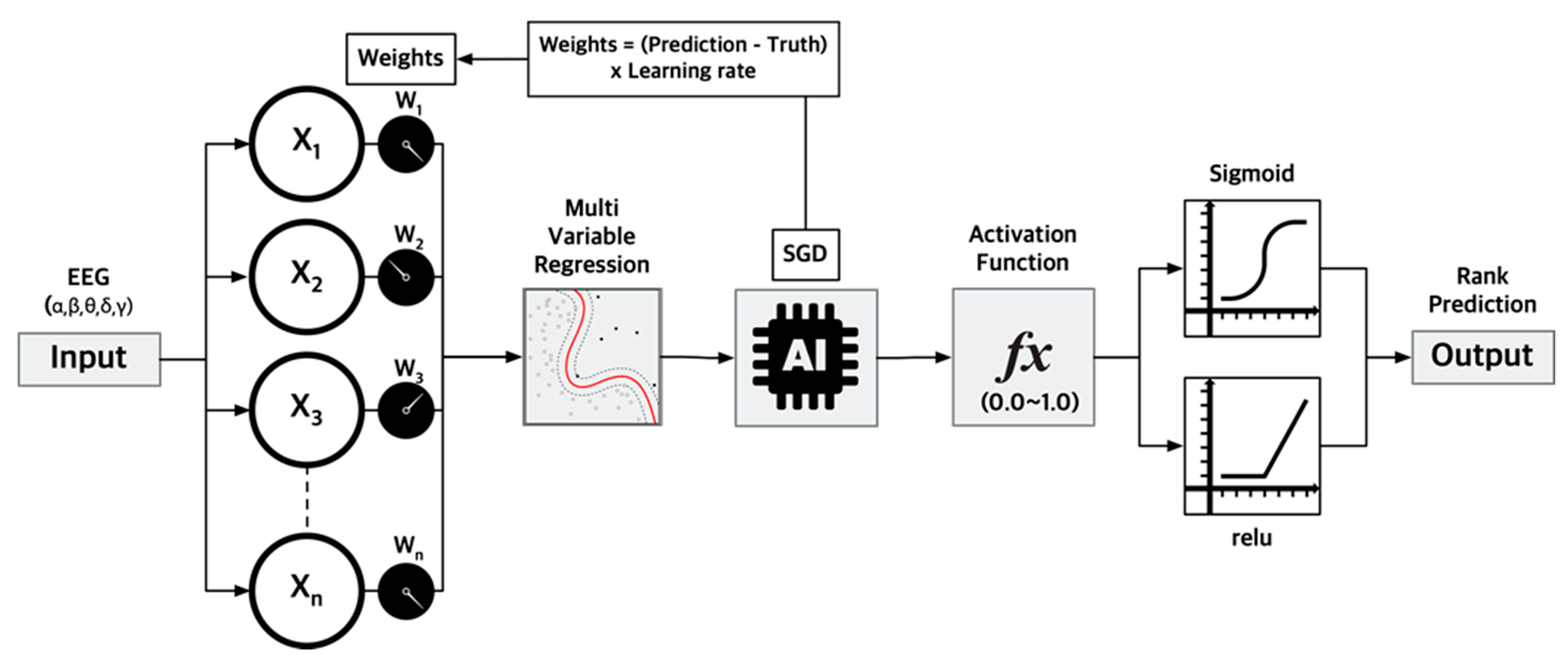
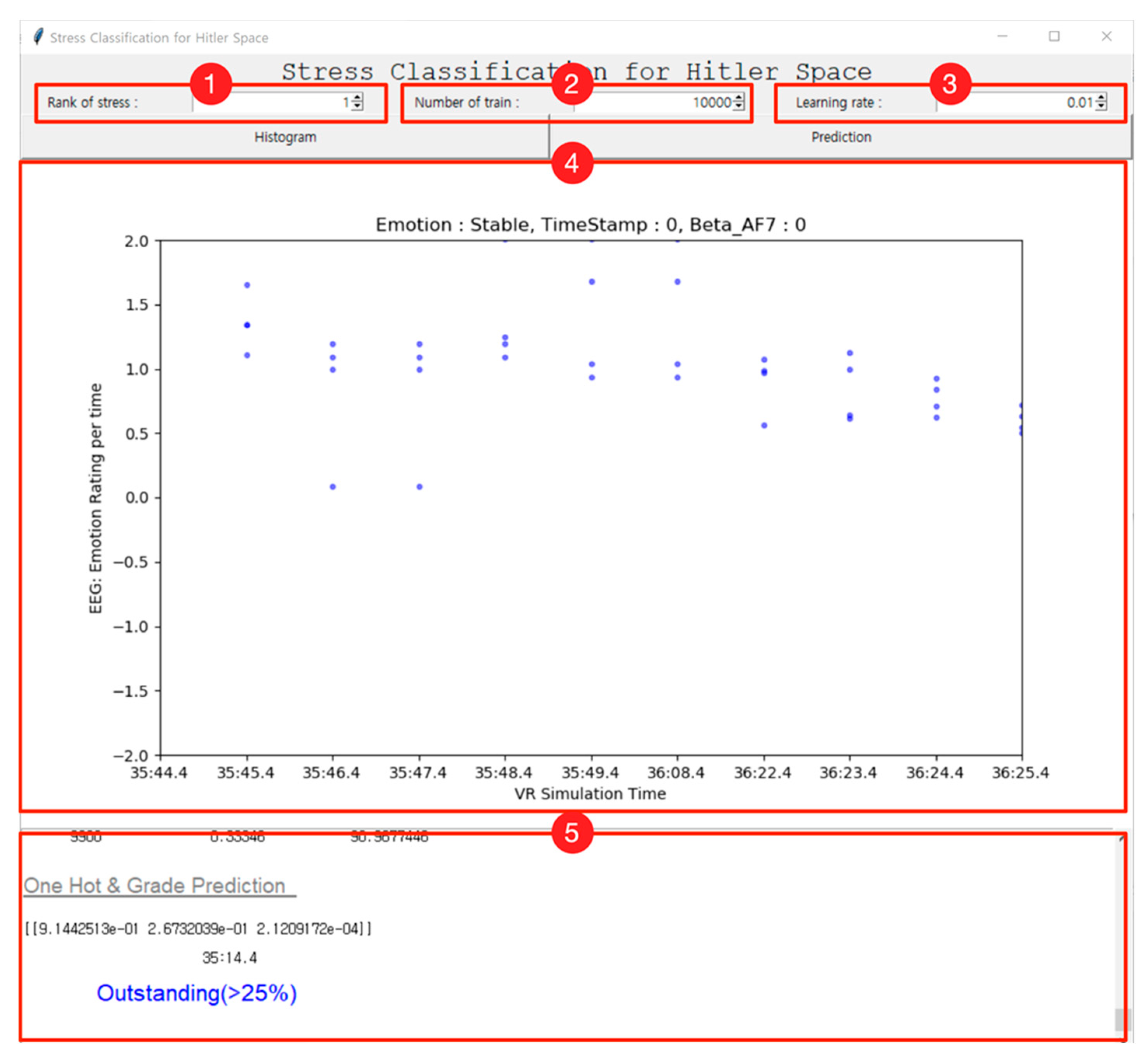
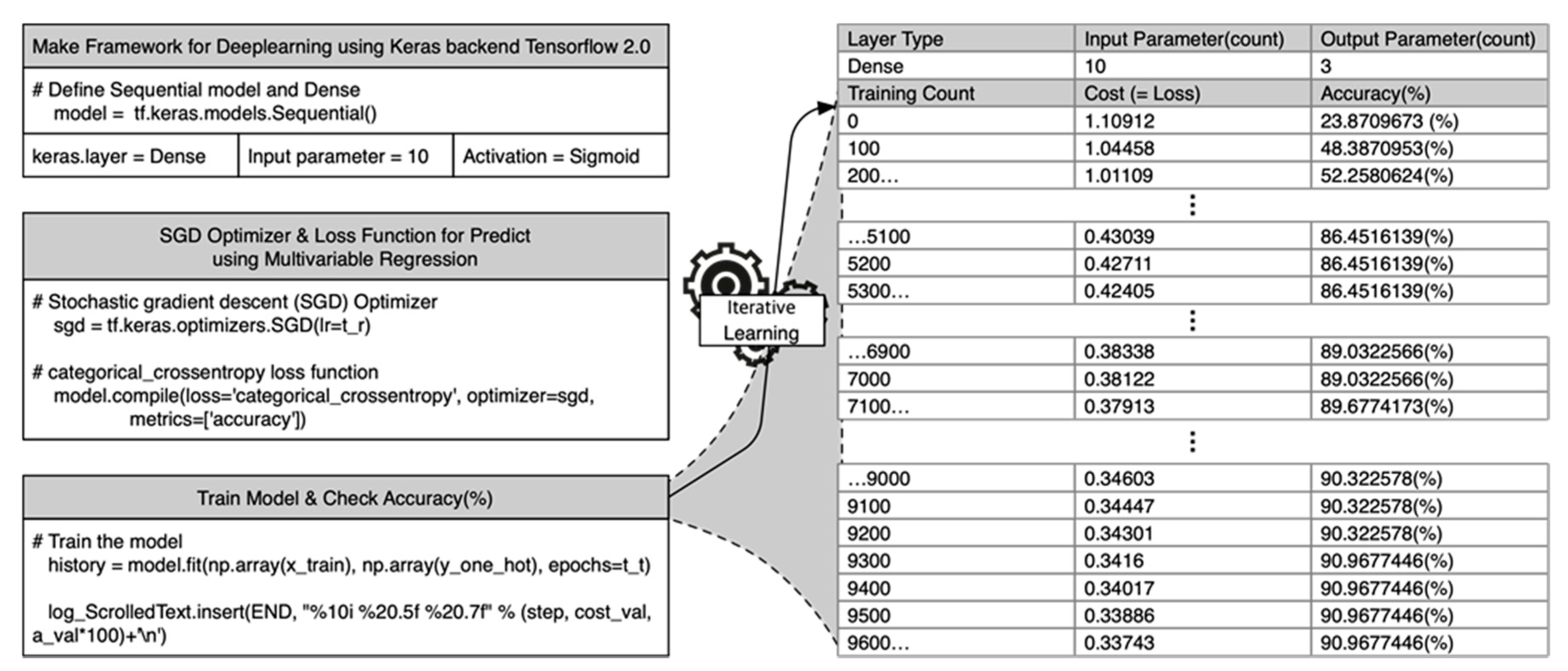
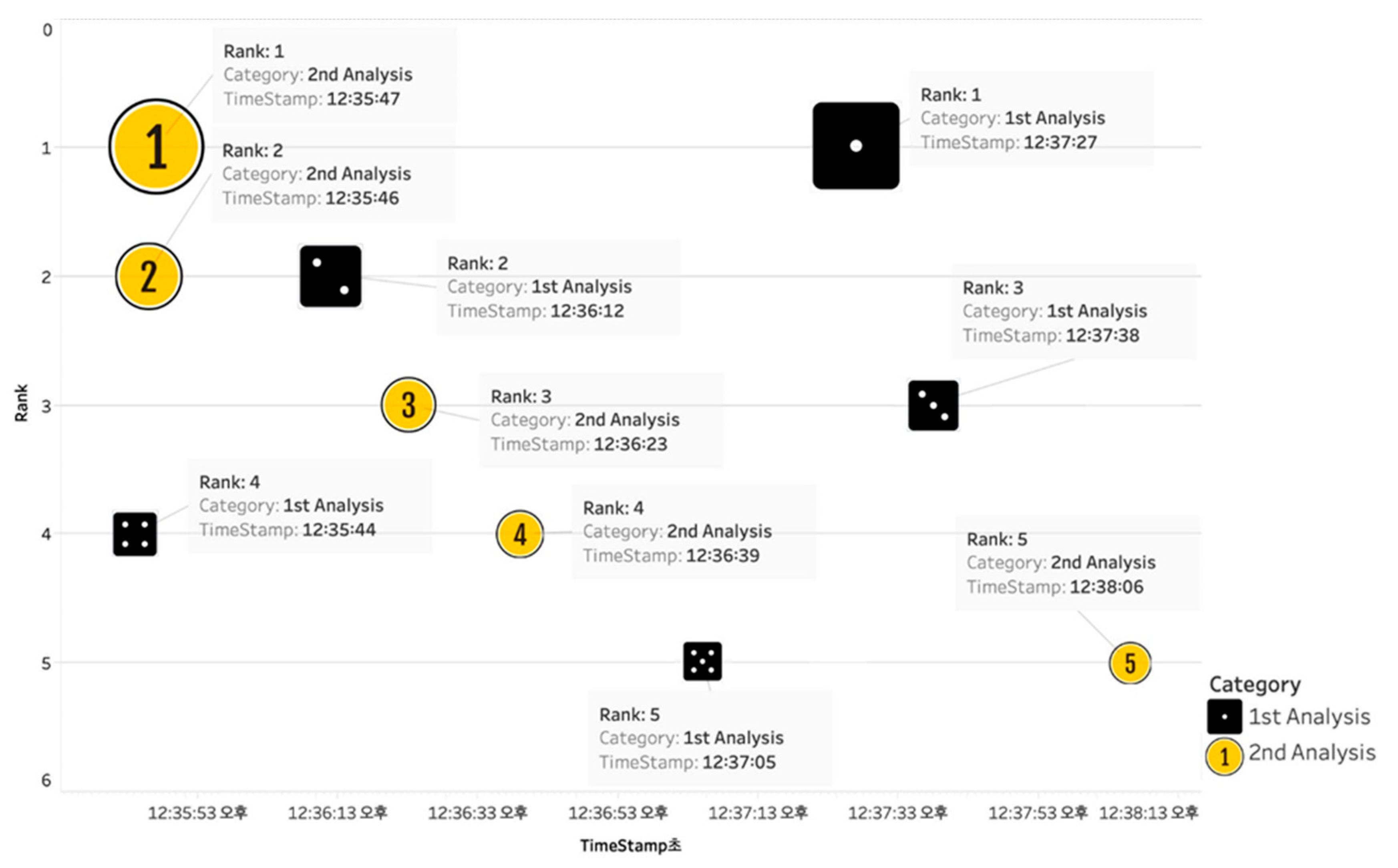
| Ranking | High Stress Time in First Experiment | Space Location | High Stress Time in Second Experiment | Space Location |
|---|---|---|---|---|
| 1 | 12:37:27 p.m. | Mosaic hall and Führerbunker transition space | 12:37:27 p.m. | Court of honor and Mosaic hall transition space |
| 2 | 12:36:12 p.m. | Court of honor and Mosaic hall transition space | 12:36:12 p.m. | Court of honor and Mosaic hall transition space |
| 3 | 12:37:38 p.m. | Führerbunker | 12:37:38 p.m. | Mosaic Hall |
| 4 | 12:35:44 p.m. | Court of Honor | 12:35:44 p.m. | Mosaic Hall |
| 5 | 12:37:05 p.m. | Court of honor and Mosaic hall transition space | 12:37:05 p.m. | Führerbunker |
| Paired Samples t-test | |||||||
|---|---|---|---|---|---|---|---|
| Statistic | Df. | p | Mean Difference | SE Difference | |||
| First Analysis | Secondary analysis | Student’s t | −23.2 | 154 | <0.001 | −1.26 | 0.0542 |
© 2020 by the authors. Licensee MDPI, Basel, Switzerland. This article is an open access article distributed under the terms and conditions of the Creative Commons Attribution (CC BY) license (http://creativecommons.org/licenses/by/4.0/).
Share and Cite
Ji, S.Y.; Kang, S.Y.; Jun, H.J. Deep-Learning-Based Stress-Ratio Prediction Model Using Virtual Reality with Electroencephalography Data. Sustainability 2020, 12, 6716. https://doi.org/10.3390/su12176716
Ji SY, Kang SY, Jun HJ. Deep-Learning-Based Stress-Ratio Prediction Model Using Virtual Reality with Electroencephalography Data. Sustainability. 2020; 12(17):6716. https://doi.org/10.3390/su12176716
Chicago/Turabian StyleJi, Seung Yeul, Se Yeon Kang, and Han Jong Jun. 2020. "Deep-Learning-Based Stress-Ratio Prediction Model Using Virtual Reality with Electroencephalography Data" Sustainability 12, no. 17: 6716. https://doi.org/10.3390/su12176716
APA StyleJi, S. Y., Kang, S. Y., & Jun, H. J. (2020). Deep-Learning-Based Stress-Ratio Prediction Model Using Virtual Reality with Electroencephalography Data. Sustainability, 12(17), 6716. https://doi.org/10.3390/su12176716





